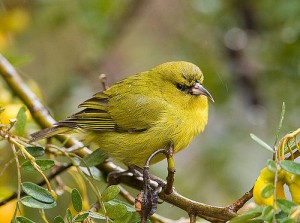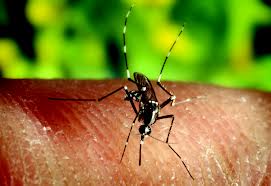24 May EARTH MATTERS: HAWAIIAN FOREST BIRDS IN PERIL

Hawaiian ‘Amakihi
Riding a warm tropical Pacific breeze and guided by the billowing cumulus clouds towering above the lofty 13,796-foot summit of Mauna Kea, forest birds arrived on the island of Hawai’i to discover a natural paradise of habitat diversity. Subsequently, the Hawaiian honeycreepers evolved into a wide variety of types, each with a specialized ecological role adapted to a specific niche.
Centuries later, the first Polynesian settlers arrived in ocean-faring canoes around 300 CE, which eventually had a negative impact on Hawaiian forest birds. Exponentially exasperating the problem was the arrival of captain James Cook from Europe in 1778. As a consequence, disease and habitat loss along with the introduction of nonnative predators and habitat competition from nonnative birds has resulted in the extinction of many Hawaiian honeycreeper species. Today, only 18 or 19 of the 55 known species of honeycreepers still exist.
Leading the decimation of the Hawaiian forest birds is the southern house mosquito, which arrived in the 1820s when its larvae most likely entered the local water supply from contaminated water casks aboard a European sailing vessel being dumped while at port. As a result, avian pox and avian malaria carried by nonnative birds brought on ships to the islands was transmitted to native Hawaiian forest birds by the newly introduced mosquitoes. Prior to this time, mosquitoes had been nonexistent on the islands. Thus, endemic forest birds had evolved without the threat of mosquito-borne diseases or the need to develop an innate defense against infection.
In addition to avian pox being virally transmitted by mosquitoes, it can also be passed to uninfected birds via physical contact with infected birds, contact with contaminated surfaces, or ingestion with contaminated food or water. Symptoms of avian pox include wart-like growths in the mouth and throat that cause difficulty with swallowing and breathing. It also involves growths forming around the eyes and beak, which impair vision and inhibit the ability to feed. In contrast, avian malaria is a protozoal disease transmitted from infected birds to uninfected birds via the saliva of mosquitoes. Following infection, the malaria parasite invades the white blood cells in a variety of tissues before invading and destroying red blood cells, which can result in death from anemia.

Mosquito
In response, some of the Hawaiian forest birds migrated to higher elevation forests, which were too cold for mosquitoes to survive. However, the higher elevations were not suitable for many of the forest birds that evolved in the lowlands. Compounding the problem, recent rising temperatures caused by anthropogenic climate change has allowed the disease carrying mosquitoes to migrate to the higher elevation forests, which were the last remaining refuge for the forest birds.
While the current trend remains disheartening for many Hawaiian forest birds, ongoing conservation efforts have stabilized or increased the population for some honeycreeper species like the bright orange Akepa (Loxops coccineus), the crimson Apapane (Himatione sanguinea), and the yellow Kauai Amakihi (Hemignathus kauaiensis).
The future health of the Hawaiian forest bird population rests in our hands.


Sorry, the comment form is closed at this time.